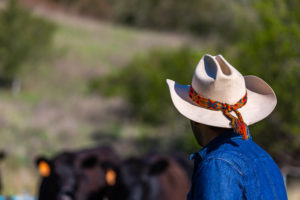A cow’s life doesn’t get better than grazing at the Santa Lucia Preserve. As hard working and highly qualified members of the Conservancy team, our bovine enjoy exceptional employee benefits. Their scope of work is primarily to eat grass, trample weeds and shrubs, and increase organic matter in our soils. Why do we need them to do this you may wonder?
 The Santa Lucia Preserve includes over 5,000 acres of grasslands, filled with incredible native plant species. In California, grasslands occur as the result of previous disturbance events, mainly fire which occurred organically as wildfires or anthropogenically by Native Americans to manage the land. After an intense shrubland or oak woodland fire, grasses take over the landscape. Immediately after taking root, these newly formed grasslands begin their transition into forest land, one shrub at a time. Once the oaks and poison oak arrive, voila! A young forest is born. Under natural cycles, another fire would occur, and the grassland would emerge again, on a very dramatic long-term rhythm.
The Santa Lucia Preserve includes over 5,000 acres of grasslands, filled with incredible native plant species. In California, grasslands occur as the result of previous disturbance events, mainly fire which occurred organically as wildfires or anthropogenically by Native Americans to manage the land. After an intense shrubland or oak woodland fire, grasses take over the landscape. Immediately after taking root, these newly formed grasslands begin their transition into forest land, one shrub at a time. Once the oaks and poison oak arrive, voila! A young forest is born. Under natural cycles, another fire would occur, and the grassland would emerge again, on a very dramatic long-term rhythm.
Fire remains one of the main drivers of vegetation change within our ecosystem, but it is not an easy tool to deploy and demands a lot of resources. An additional challenge facing grasslands are newcomer plant species that compete for natives’ resources which reduces their chance of survival. This new reality requires innovative solutions within a shifting landscape. For the Conservancy, cattle grazing is an important part of the solution.
 By grazing tall annual grasses and trampling stands of weeds, like thistle and hemlock, the cows give flowering plants and native grasses a competitive edge by increasing access to the resources they need to grow. Cattle provide other benefits too, like eliminating thatch, the dead plant material from previous years that form a thick cover on the ground. As they move through grazing pastures, cows break shrubs underfoot and when they scratch against the brush, it helps to suppress the natural succession of grasslands to shrublands, and eventually woodlands.
By grazing tall annual grasses and trampling stands of weeds, like thistle and hemlock, the cows give flowering plants and native grasses a competitive edge by increasing access to the resources they need to grow. Cattle provide other benefits too, like eliminating thatch, the dead plant material from previous years that form a thick cover on the ground. As they move through grazing pastures, cows break shrubs underfoot and when they scratch against the brush, it helps to suppress the natural succession of grasslands to shrublands, and eventually woodlands.
Thanks to the cows’ hard work, we enjoy many benefits to The Preserve’s ecological system. In return, our cattle enjoy unparalleled employee benefits. Consistent with the culinary experience The Preserve provides to Members, our cows enjoy freshly catered grass, hence their constant movement.
 Modern cows are the descendants of gregarious migratory herbivores that were always on the move together in search of the best forage. Conservancy staff are constantly constructing and deconstructing fences so that our cattle enjoy the best forage containing the most nutrients on The Preserve. The cows enjoy The Preserve’s premium water too, as their troughs are filled via the vast fire hydrant infrastructure. Our herd even receives personalized health care with staff who monitor their wellbeing and routinely assess grassland conditions and nutrients.
Modern cows are the descendants of gregarious migratory herbivores that were always on the move together in search of the best forage. Conservancy staff are constantly constructing and deconstructing fences so that our cattle enjoy the best forage containing the most nutrients on The Preserve. The cows enjoy The Preserve’s premium water too, as their troughs are filled via the vast fire hydrant infrastructure. Our herd even receives personalized health care with staff who monitor their wellbeing and routinely assess grassland conditions and nutrients.
After more than a decade working in, and visiting cattle ranches in Mexico and the U.S., I can attest that our relationship with the Santa Lucia herd is hard to find anywhere else. Conservancy staff serenade the cows, calling to them, as they follow us from one pasture to the next. Rather than fearing people, our cows are curious and tend to move closer to onlookers.
Our grazing technicians, Kyle Meyer and Dayna Cormany, along with Rue, our cattle dog, are integral team members, ensuring the herd stays together as they move from one pasture to the next. Occasionally, a cow might think the grass is greener on the other side. When that happens, Rue is the best in class at returning the rogue cow. The border collie enjoys her role so much, she even helps our neighbors, when their cows escape to The Preserve, where the grass really is greener.
Ultimately, our work at the Conservancy is to balance cattle and grassland health, recognizing and celebrating our cattle as crucial members of the stewardship team.
BY RODRIGO SIERRA CORONA
